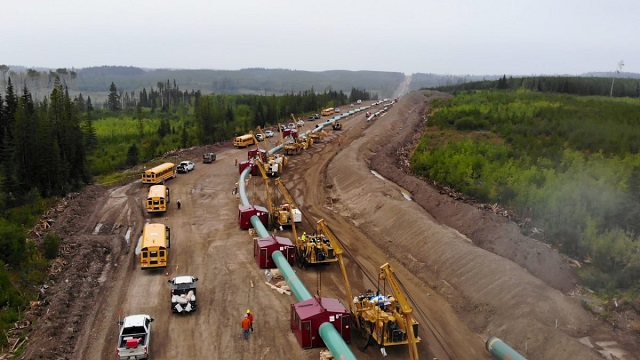Energy
The 2015 Paris agreement outdated by AI advancement

From Resource Works
Evolving economy is running circles around green ambitions
In 2015 world leaders met in Paris to set the course for climate action and agreed to limit global warming to well below 2°C above pre-industrial levels. Those targets relied heavily on getting to 100% renewable energy, electrifying transport and reducing fossil fuels. But one big factor was left out of those plans: the rapid growth of artificial intelligence (AI) and the massive energy it’s consuming. Now as AI is becoming a pillar of the global economy, climate goals remain stagnant, and we need to ask the big questions about how we reconcile progress with responsibility.
AI’s rapid growth, especially since the introduction of generative AI tools like ChatGPT and MidJourney, has upended industries and created unprecedented demand for computer power. Training and running advanced AI models requires vast amounts of energy, mostly to power the data centers where the computations are done. These facilities use as much electricity as a medium sized city and are straining local grids and making it harder to decarbonize the power system.
The scale of this demand was not factored in when nations were setting their climate strategies in 2015. While many plans accounted for electrification of transport and heating, AI was still an emerging idea. Today the data center industry, driven by AI, cloud computing and internet usage, accounts for about 3% of global electricity consumption and that’s expected to rise sharply as AI adoption grows.
The energy challenges of AI are particularly acute in British Columbia, Canada where a clean electricity grid was once the foundation of the province’s climate strategy. BC Hydro, the publicly owned utility, generates most of its electricity from hydro. But recent data shows BC Hydro can’t meet domestic demand without importing electricity from neighboring regions including Alberta and the US where fossil fuels dominate the energy mix.
In the last fiscal year BC imported over 13,600 gigawatt-hours of electricity – more than double the annual output of the controversial Site C dam, a $16 billion hydro project currently under construction. Importing electricity undermines the province’s green credentials and raises questions about how it will meet future demand as data centers grow to support AI.
Climate goals initially focused on reducing emissions from transport and industrial processes are now being challenged by the energy demands of AI. For example, policies promoting electric vehicles (EVs) assumed electricity demand would grow incrementally but AI is upending those calculations. Data centers designed to power AI workloads require massive energy densities and continuous operation and are adding stress to grids already dealing with EVs and renewable energy integration.
Globally nations are facing similar dilemmas. In the US data centers are driving demand for new natural gas plants even as the federal government is committing to decarbonize the grid by 2035. Meanwhile countries like Ireland and the Netherlands have temporarily halted approvals for new data center connections to protect grid stability and meet emissions reduction targets. These tensions are highlighting the growing challenge of balancing climate goals with the demands of a digital economy which now has the added pressure of AI.
AI and its energy demands have added a new layer of complexity for climate policymakers. Some say the solution is to accelerate the transition to renewable energy and invest in advanced technologies like small modular reactors (SMRs) and energy storage. Others say it’s about improving data center efficiency through liquid cooling and more efficient chips.
But these solutions take time and capital and may not be enough to keep up with the rapid growth of AI driven energy demand. Policymakers will have to make tough choices: should resources be directed towards building more renewable capacity to support AI or should data center growth be limited? And how can we make sure AI’s benefits outweigh its costs?
The AI revolution has blown apart assumptions about energy demand and emissions reduction pathways and we need to face the reality of our existing climate strategies. As British Columbia is trying to balance the promise of AI with a sustainable future the time to act has never been more pressing. A net zero world will require not only innovation but also a willingness to confront the trade-offs that come with plugging in these transformative technologies to our planet.
Carbon Tax
Carney fails to undo Trudeau’s devastating energy policies

From the Fraser Institute
By Tegan Hill and Elmira Aliakbari
On the campaign trail and after he became prime minister, Mark Carney has repeatedly promised to make Canada an “energy superpower.” But, as evidenced by its first budget, the Carney government has simply reaffirmed the failed plans of the past decade and embraced the damaging energy policies of the Trudeau government.
First, consider the Trudeau government’s policy legacy. There’s Bill C-69 (the “no pipelines act”), the new electricity regulations (which aim to phase out natural gas as a power source starting this year), Bill C-48 (which bans large oil tankers off British Columbia’s northern coast and limit Canadian exports to international markets), the cap on emissions only from the oil and gas sector (even though greenhouse gas emissions have the same effect on the environment regardless of the source), stricter regulations for methane emissions (again, impacting the oil and gas sector), and numerous “net-zero” policies.
According to a recent analysis, fully implementing these measures under Trudeau government’s emissions reduction plan would result in 164,000 job losses and shrink Canada’s economic output by 6.2 per cent by the end of the decade compared to a scenario where we don’t have these policies in effect. For Canadian workers, this will mean losing $6,700 (annually, on average) by 2030.
Unfortunately, the Carney government’s budget offers no retreat from these damaging policies. While Carney scrapped the consumer carbon tax, he plans to “strengthen” the carbon tax on industrial emitters and the cost will be passed along to everyday Canadians—so the carbon tax will still cost you, it just won’t be visible.
There’s also been a lot of buzz over the possible removal of the oil and gas emissions cap. But to be clear, the budget reads: “Effective carbon markets, enhanced oil and gas methane regulations, and the deployment at scale of technologies such as carbon capture and storage would create the circumstances whereby the oil and gas emissions cap would no longer be required as it would have marginal value in reducing emissions.” Put simply, the cap remains in place, and based on the budget, the government has no real plans to remove it.
Again, the cap singles out one source (the oil and gas sector) of carbon emissions, even when reducing emissions in other sectors may come at a lower cost. For example, suppose it costs $100 to reduce a tonne of emissions from the oil and gas sector, but in another sector, it costs only $25 a tonne. Why force emissions reductions in a single sector that may come at a higher cost? An emission is an emission regardless of were it comes from. Moreover, like all these policies, the cap will likely shrink the Canadian economy. According to a 2024 Deloitte study, from 2030 to 2040, the cap will shrink the Canadian economy (measured by inflation-adjusted GDP) by $280 billion, and result in lower wages, job losses and a decline in tax revenue.
At the same time, the Carney government plans to continue to throw money at a range of “green” spending and tax initiatives. But since 2014, the combined spending and forgone revenue (due to tax credits, etc.) by Ottawa and provincial governments in Ontario, Quebec, British Columbia and Alberta totals at least $158 billion to promote the so-called “green economy.” Yet despite this massive spending, the green sector’s contribution to Canada’s economy has barely changed, from 3.1 per cent of Canada’s economic output in 2014 to 3.6 per cent in 2023.
In his first budget, Prime Minister Carney largely stuck to the Trudeau government playbook on energy and climate policy. Ottawa will continue to funnel taxpayer dollars to the “green economy” while restricting the oil and gas sector and hamstringing Canada’s economic potential. So much for becoming an energy superpower.
Business
Large-scale energy investments remain a pipe dream

I view the recent announcements by the Government of Canada as window dressing, and not addressing the fundamental issue which is that projects are drowning in bureaucratic red tape and regulatory overburden. We don’t need them picking winners and losers, a fool’s errand in my opinion, but rather make it easier to do business within Canada and stop the hemorrhaging of Foreign Direct Investment from this country.
Thanks for reading William’s Substack!
Subscribe for free to receive new posts and support my work.
Changes are afoot—reportedly, carve-outs and tweaks to federal regulations that would help attract investment in a new oil pipeline from Alberta. But any private proponent to come out of this deal will presumably be handpicked to advance through the narrow Bill C-5 window, aided by one-off fixes and exemptions.
That approach can only move us so far. It doesn’t address the underlying problem.
Anyone in the investment world will tell you a patchwork of adjustments is nowhere near enough to unlock the large-scale energy investment this country needs. And from that investor’s perspective, the horizon stretches far beyond a single political cycle. Even if this government promises clarity today in the much-anticipated memorandum of understanding (MOU), who knows whether it will be around by the time any major proposal actually moves forward.
With all of the talk of “nation-building” projects, I have often been asked what my thoughts are about what we must see from the federal government.
The energy sector is the file the feds have to get right. It is by far the largest component of Canadian exports, with oil accounting for $147 billion in 2024 (20 percent of all exports), and energy as a whole accounting for $227 billion of exports (30 percent of all exports).
Furthermore, we are home to some of the largest resource reserves in the world, including oil (third-largest in proven reserves) and natural gas (ninth-largest). Canada needs to wholeheartedly embrace that. Natural resource exceptionalism is exactly what Canada is, and we should be proud of it.
One of the most important factors that drives investment is commodity prices. But that is set by market forces.
Beyond that, I have always said that the two most important things one considers before looking at a project are the rule of law and regulatory certainty.
The Liberal government has been obtuse when it comes to whether it will continue the West Coast tanker ban (Bill C-48) or lift it to make way for a pipeline. But nobody will propose a pipeline without the regulatory and legal certainty that they will not be seriously hindered should they propose to build one.
Meanwhile, the proposed emissions cap is something that sets an incredibly negative tone, a sentiment that is the most influential factor in ensuring funds flow. Finally, the Impact Assessment Act, often referred to as the “no more pipelines bill” (Bill C-69), has started to blur the lines between provincial and federal authority.
All three are supposedly on the table for tweaks or carve-outs. But that may not be enough.
It is interesting that Norway—a country that built its wealth on oil and natural gas—has adopted the mantra that as long as oil is a part of the global economy, it will be the last producer standing. It does so while marrying conventional energy with lower-carbon standards. We should be more like Norway.
Rather than constantly speaking down to the sector, the Canadian government should embrace the wealth that this represents and adopt a similar narrative.
The sector isn’t looking for handouts. Rather, it is looking for certainty, and a government proud of the work that they do and is willing to say so to Canada and the rest of the world. Foreign direct investment outflows have been a huge issue for Canada, and one of the bigger drags on our economy.
Almost all of the major project announcements Prime Minister Mark Carney has made to date have been about existing projects, often decades in the making, which are not really “additive” to the economy and are reflective of the regulatory overburden that industry faces en masse.
I have always said governments are about setting the rules of the game, while it is up to businesses to decide whether they wish to participate or to pick up the ball and look elsewhere.
Capital is mobile and will pursue the best risk-adjusted returns it can find. But the flow of capital from our country proves that Canada is viewed as just too risky for investors.
The government’s job is not to try to pick winners and losers. History has shown that governments are horrible at that. Rather, it should create a risk-appropriate environment with stable and capital-attractive rules in place, and then get out of the way and see where the chips fall.
Link to The Hub article: Large-scale energy investments remain a pipe dream
Formerly the head of institutional equity research at FirstEnergy Capital Corp and ATB Capital Markets. I have been involved in the energy sector in either the sell side or corporately for over 25 years
Thanks for reading William’s Substack!
Subscribe for free to receive new posts and support my work.
-

 Business2 days ago
Business2 days agoBudget 2025: Ottawa Fakes a Pivot and Still Spends Like Trudeau
-

 Health2 days ago
Health2 days agoTens of thousands are dying on waiting lists following decades of media reluctance to debate healthcare
-

 Opinion2 days ago
Opinion2 days agoLandmark 2025 Study Says Near-Death Experiences Can’t Be Explained Away
-

 International15 hours ago
International15 hours ago“The Largest Funder of Al-Shabaab Is the Minnesota Taxpayer”
-

 Focal Points2 days ago
Focal Points2 days agoSTUDY: TikTok, Instagram, and YouTube Shorts Induce Measurable “Brain Rot”
-

 Censorship Industrial Complex18 hours ago
Censorship Industrial Complex18 hours agoUK Government “Resist” Program Monitors Citizens’ Online Posts
-

 Bruce Dowbiggin21 hours ago
Bruce Dowbiggin21 hours agoElbows Down For The Not-So-Magnificent Seven: Canada’s Wilting NHL Septet
-

 Alberta17 hours ago
Alberta17 hours agoPremier Smith explains how private clinics will be introduced in Alberta










